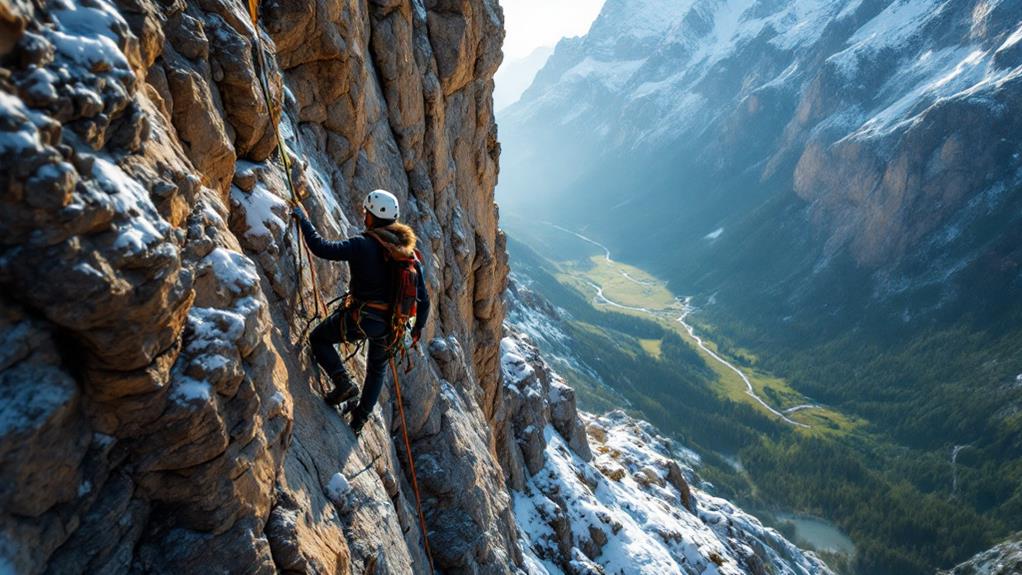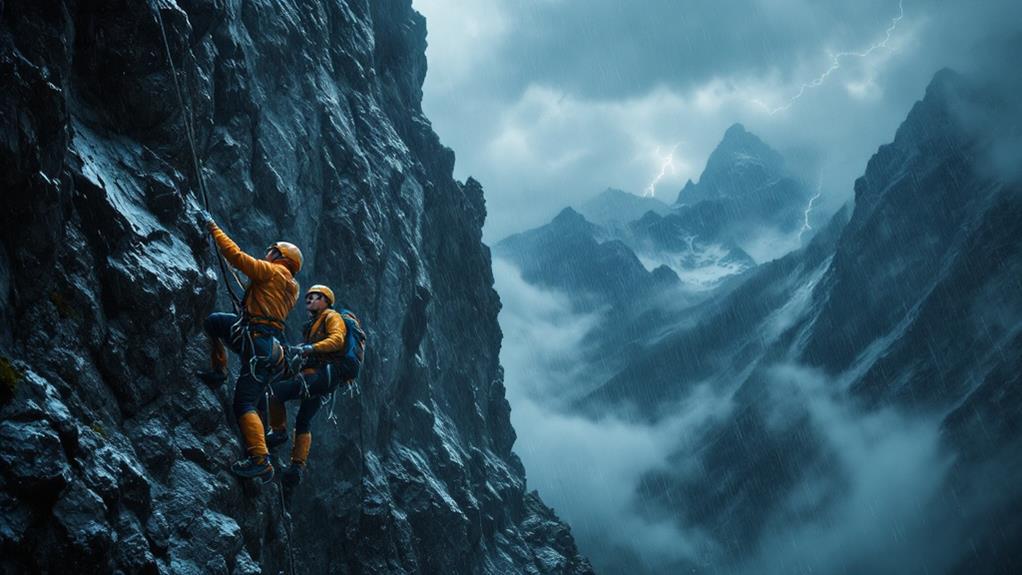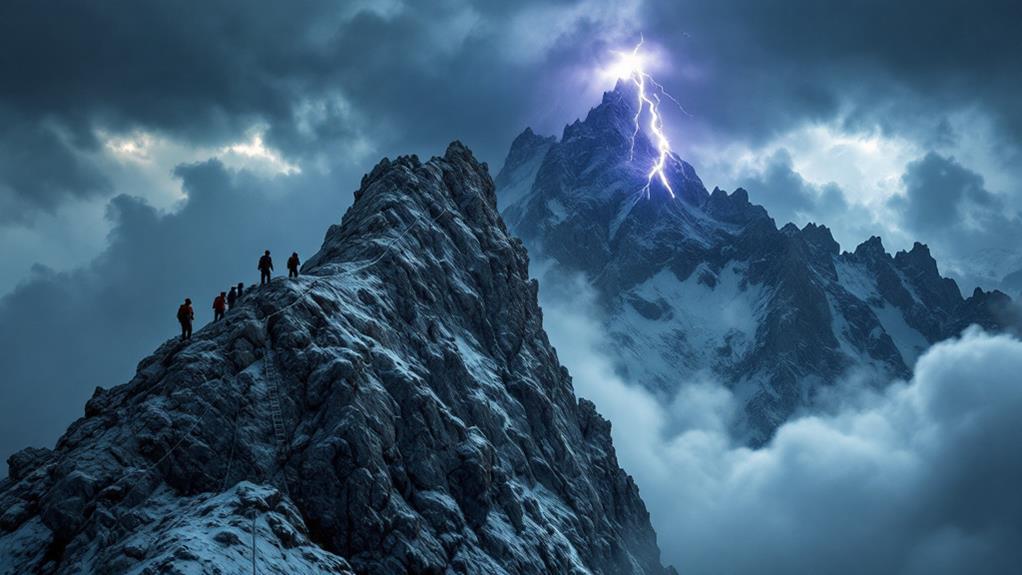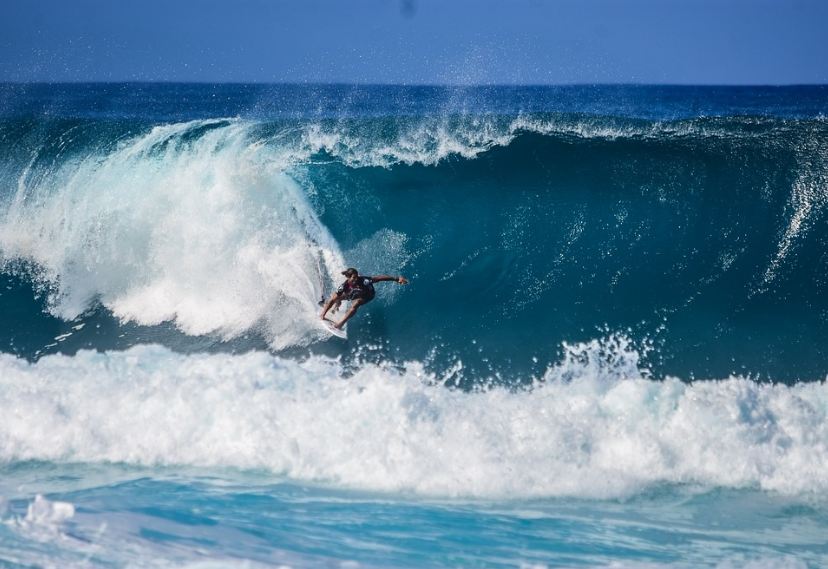What Are the Risks of via Ferrata?

Via ferrata routes pose several significant risks you need to be aware of. You're exposed to equipment failure, falls, and slips on steep terrain. Adverse weather can make conditions treacherous, while rockfall hazards threaten from above. It's easy to overestimate your abilities or make navigation errors, leading to dangerous situations. Popular routes can become overcrowded, increasing risks. Lightning strikes are a serious concern due to metal equipment. At higher altitudes, you may face health issues related to decreased oxygen. Understanding these dangers is crucial for a safe via ferrata experience, but there's more to consider before you clip in.
Equipment Failure
While via ferrata equipment is designed to be robust, it's not immune to failure. You're relying on various pieces of gear to keep you safe, including harnesses, carabiners, lanyards, and fixed cables. Each of these components can potentially malfunction or break, especially if they're not properly maintained or inspected regularly.
Harnesses can develop weak spots or frayed areas over time, compromising their integrity. Carabiners may have faulty gates that don't close properly, increasing the risk of accidental unhooking. Lanyards can suffer from wear and tear, particularly at connection points. The fixed cables and anchors along the route might corrode or loosen due to weathering and frequent use.
You should always inspect your personal equipment before each climb and be aware of the condition of the fixed installations. Don't hesitate to abort your climb if you notice any signs of damage or wear. It's crucial to replace gear according to manufacturer guidelines and to avoid using equipment that's past its recommended lifespan. Remember, your life depends on these tools, so treat them with the utmost care and respect.
Falls and Slips
Despite safety equipment, falls and slips remain a significant risk on via ferrata routes. You're exposed to steep terrain, often with sheer drops, and the combination of altitude, fatigue, and challenging conditions can increase your chances of losing your footing. Even a minor slip can lead to serious injuries or a potentially fatal fall if you're not properly secured.
Weather plays a crucial role in your safety. Wet or icy conditions make metal rungs and cables slippery, dramatically increasing the risk of falls. You'll need to be extra cautious during or after rain, and some routes may become impassable in winter due to ice and snow.
Fatigue is another factor that can contribute to falls. As you climb, your muscles tire, and your concentration may wane, making it easier to misplace a foot or lose your grip. It's essential to know your limits and take breaks when needed.
Loose rocks pose an additional hazard. A dislodged stone can cause you to lose balance or injure other climbers below. Always test holds before fully committing your weight and be aware of your surroundings.
Adverse Weather Conditions

Thunderstorms and sudden weather changes can turn a via ferrata adventure into a perilous ordeal. When you're exposed on a mountain face, adverse weather conditions pose significant risks. Heavy rain can make metal rungs and cables slippery, increasing the chance of falls. Strong winds might throw you off balance, especially on exposed sections or while crossing wire bridges.
Lightning strikes are particularly dangerous on via ferratas due to the metal equipment. If you hear thunder or see dark clouds approaching, it's crucial to descend immediately or seek shelter in a safe location. Fog can also be treacherous, obscuring your vision and making route-finding difficult.
To vividly illustrate the impact of adverse weather, imagine:
- Rain pelting your face as you struggle to grip a slick metal ladder
- Gusts of wind threatening to tear you from the cliff face
- A sudden whiteout leaving you disoriented and clinging to the cable
Always check the weather forecast before embarking on a via ferrata route. Be prepared to turn back if conditions deteriorate. Carry appropriate gear, including waterproof clothing and emergency supplies, to handle unexpected weather changes.
Rockfall Hazards
How often do you consider the rocks above you when climbing a via ferrata? Rockfall hazards pose a significant risk on these routes, and you shouldn't underestimate their potential danger. Loose rocks can be dislodged by climbers above you, wildlife, or natural erosion processes. Proper training and experience are necessary to manage these risks. Even small rocks falling from a height can gain tremendous momentum and cause serious injury. You're particularly vulnerable when you're attached to the cable, as your ability to quickly move out of the way is limited. To minimize this risk, always wear a certified climbing helmet and stay alert to your surroundings.
Listen for warning shouts from other climbers and be prepared to take cover if necessary. If you're climbing in a group, maintain adequate spacing to reduce the risk of dislodging rocks onto those below you. Be cautious when pulling on holds or stepping on ledges, as they may be loose or unstable. Weather conditions can also increase rockfall risk. After heavy rain or during freeze-thaw cycles, rocks may become less stable. If you notice an unusually high amount of debris on the route, consider postponing your climb or choosing an alternative path.
Overestimating Personal Abilities

Many climbers fall into the trap of overestimating their personal abilities on via ferrata routes. This overconfidence can lead to dangerous situations and potentially life-threatening mistakes. You might think you're in better physical shape or have more climbing experience than you actually do, pushing yourself beyond your limits.
To avoid this risk, honestly assess your skills and fitness level before attempting a via ferrata. Consider these factors:
- Your endurance - Can you sustain physical exertion for several hours?
- Your upper body strength - Are you able to pull yourself up using only your arms?
- Your fear of heights - How comfortable are you with exposure and vertical drops?
Inadequate Physical Preparation
Inadequate physical preparation is a major pitfall for via ferrata enthusiasts. You might underestimate the physical demands of this activity, assuming it's similar to casual hiking. However, via ferrata routes often involve extended periods of climbing, requiring significant upper body strength and endurance. If you're not in proper shape, you'll quickly tire, increasing your risk of accidents and falls.
To avoid this danger, you should engage in regular cardio exercises to build stamina and incorporate strength training for your arms, shoulders, and core. Focus on exercises that mimic climbing movements, such as pull-ups, push-ups, and planks. Don't forget to improve your grip strength, as you'll be hanging onto metal rungs for extended periods.
Additionally, practice climbing techniques on easier routes or at indoor climbing gyms before attempting challenging via ferratas. This will help you develop the necessary skills and muscle memory. Remember, altitude can also affect your physical performance, so if you're tackling high-altitude routes, acclimatize properly beforehand. By adequately preparing your body, you'll significantly reduce the risks associated with via ferrata and enjoy a safer, more rewarding experience.
Route Navigation Errors

Route navigation errors frequently plague even experienced via ferrata climbers. You might find yourself in a precarious situation if you're not diligent about following the correct path. These errors can lead to dangerous detours, unnecessary risk-taking, and potential accidents.
To avoid route navigation mistakes, you'll need to:
- Study the route map thoroughly before starting your climb
- Pay close attention to route markers and signage along the way
- Carry a detailed guidebook or GPS device for reference
It's crucial to stay focused and aware of your surroundings at all times. Don't let fatigue or distractions cloud your judgment. If you're unsure about the correct path, take a moment to reassess your position and consult your resources. Remember, it's better to backtrack and find the right route than to forge ahead on a potentially dangerous path.
Weather conditions can also impact route visibility, making navigation more challenging. Be prepared for sudden changes in visibility due to fog, rain, or darkness. Always carry a headlamp and extra batteries in case your climb takes longer than expected. By staying vigilant and well-prepared, you'll minimize the risk of route navigation errors and enjoy a safer via ferrata experience.
Overcrowding on Popular Routes
A significant challenge faced by via ferrata enthusiasts is the issue of overcrowding on popular routes. As these climbing paths gain popularity, you'll often find yourself sharing the experience with numerous other climbers. This can lead to several risks and inconveniences.
Firstly, overcrowding can cause delays and bottlenecks at key points along the route. You might find yourself waiting for extended periods at ladders, bridges, or narrow sections, potentially disrupting your planned schedule and increasing the risk of fatigue or exposure to changing weather conditions.
Secondly, the presence of many climbers can increase the likelihood of falling objects. With more people above you, there's a higher chance of dislodged rocks or dropped equipment. Always wear a helmet and remain vigilant.
Thirdly, overcrowding can create pressure to move quickly, potentially leading to rushed decisions or skipping safety checks. Don't let others' impatience compromise your safety.
To mitigate these risks, consider visiting popular routes during off-peak hours or seasons. Alternatively, seek out less-traveled via ferratas to enjoy a more serene and potentially safer climbing experience.
Lightning Strikes

Thunderous skies pose a significant danger for via ferrata climbers. You're particularly vulnerable to lightning strikes when you're on a metal cable or ladder, as these conduct electricity. If you're caught in a storm while on a via ferrata route, you're at serious risk of electrocution or falls caused by sudden shocks.
To minimize your risk, always check weather forecasts before setting out. If you see dark clouds approaching or hear thunder, it's crucial to descend immediately. Don't wait for the storm to arrive – lightning can strike from miles away. If you can't get off the route in time, try to find shelter in a cave or under an overhang, avoiding tall objects and metal equipment.
During a thunderstorm, you might experience:
- Hair standing on end (a sign of electrical charge buildup)
- Buzzing sounds from your gear
- A tingling sensation on your skin
Altitude-Related Health Issues
Thin air at high altitudes can pose serious health risks for via ferrata climbers. As you ascend, the air pressure decreases, reducing the amount of oxygen available to your body. This can lead to altitude sickness, which may manifest as headaches, nausea, dizziness, and fatigue. In severe cases, it can progress to more serious conditions like High Altitude Pulmonary Edema (HAPE) or High Altitude Cerebral Edema (HACE), both of which can be life-threatening.
To minimize these risks, you should acclimatize properly before attempting high-altitude via ferrata routes. Ascend gradually, allowing your body time to adjust to the changing conditions. Stay well-hydrated and avoid alcohol, which can exacerbate symptoms. Be aware of early warning signs and don't hesitate to descend if you experience severe symptoms. It's crucial to listen to your body and not push beyond your limits.
If you have pre-existing health conditions, particularly heart or lung issues, consult your doctor before attempting high-altitude climbs. Remember, altitude-related illnesses can affect anyone, regardless of fitness level or previous climbing experience. Always prioritize safety over reaching the summit.




